Thanks Dave

. I was particularly taken with that Marsh Fritillary myself. Like you say, a very variable species but I've not seen many with that yellowish tone before.
Looking back at 2019 Part 2 – Into Summer.
As we passed from late spring into early summer, the beginning of June continued the theme of mixed weather although the balance seemed to shift to more cloud and rain. Numbers of typical spring butterflies were now dwindling and as yet the common early summer species had yet to appear locally.
Over the past few years I have read a few comments on UKB about a lack of a ‘June Gap’. This may well be true in areas which are fortunate to have some premium species close by, but my local spots (by which I mean within the boundaries of Solihull) are relatively species poor with just the common and widespread species to be found. This means that I still see a definite gap between the spring species fading and the summer ones appearing. This does not mean that I don’t see any butterflies at all as there are always a few late spring butterflies still hanging on and the first Large Skippers often start appearing around now.
Of course, this gap can be filled by travelling, and I often choose to have a few days away around this time to catch up with species from further afield. This year we went north again to stay for a few days in the Arnside & Silverdale area.
We drove up on June 9th and as is often the case when travelling up there, we arrived with plenty of time to call in at Warton Crag where I soon managed to catch up with two of my targets for the trip. The first of these was Small Pearl-bordered Fritillary, of which I saw half a dozen or so, all fresh males. A couple of fresh male Northern Brown Argus were also seen which ticked the second target.
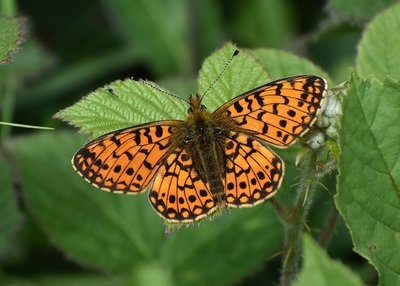
- Small Pearl-bordered Fritillary - Warton Crag 09.06.2019
The following day (June 10th) we took a drive up to Irton Fell where I saw approx. 40-50 Mountain Ringlets, some of which were already looking a bit faded and worn.
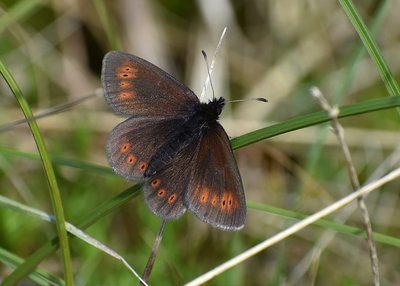
- Mountain Ringlet - Irton Fell 10.06.2019
On the way back to our B&B we called in at Meathop Moss where I saw my fourth and last target for the trip, Large Heath. These seemed to be flying in good numbers when the sun came out, although the very wet moss meant that sticking to the board walk was essential and meant that only a small proportion of those flying could be observed.
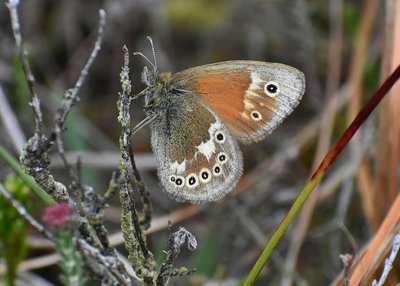
- Large Heath - Meathop Moss 10.06.2019
Latterbarrow LNR, across the road from Meathop Moss, produced a few more NBA, still all males and a female SPBF.
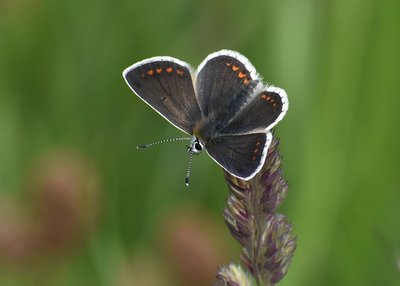
- Norther Brown Argus (salmacis) - Latterbarrow 10.06.2019
Latterbarrow also produced my first Large Skippers and Meadow Browns of the year. I nearly always see the first examples of both species during one of our trips away as they seem to appear nearly everywhere a few days before they do at home.
Back home, the Large Skippers and Meadow Browns were flying by the middle of the month and were then joined by the first Summer brood Small Tortoiseshells. Also, summer brood Speckled Woods usually start emerging around here sometime in June. This year I saw the first fresh summer male in my garden at the end of May although numbers didn’t build until the second half of June.
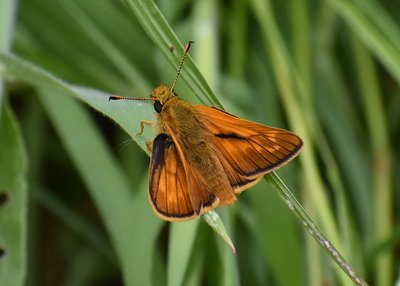
- Large Skipper - Bickenhill Solihull 16.06.2019
I mentioned in part 1 of my look back that I was keen to catch up with some fritillaries this year, having missed most of them in 2018, and so our second trip of the year saw us heading down to The Heddon Valley in late June. On the way down, we stopped off at Haddon Hill but our arrival there was met with low cloud and rain. Despite the unpromising conditions I managed to find a single roosting Heath Fritillary and took what are my best underside shots of this species to date.
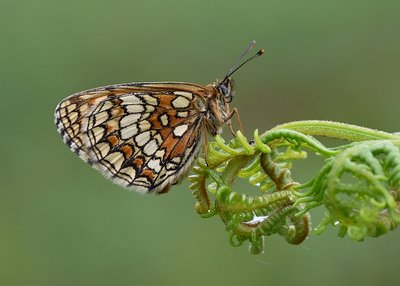
- Heath Fritillary - Haddon Hill 23.06.2019
We had seen a lot of dull and cloudy weather and a fair bit of rain so far in June, so it was a relief to get some dry weather for our stay in the Heddon Valley, although there was still a fair bit of cloud about and temperatures were not particularly high. I saw reasonably good numbers of both High Brown and Dark Green Fritillaries although neither were quite as numerous as I have seen here in previous visits. Having said that the examples of both species that I saw were mostly males in good condition, so they were possibly still to reach peak numbers.
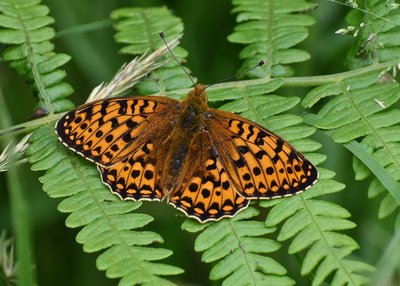
- Dark Green Fritillary - Heddon Valley 24.06.2019
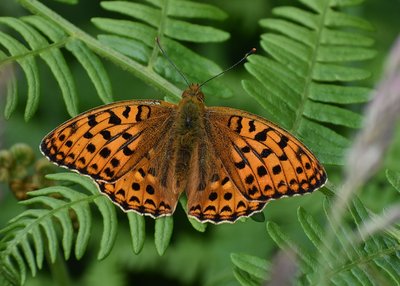
- High Brown Fritillary - Heddon Valley 24.06.2019
I also saw a few fresh male Silver-washed Fritillaries, my first of the year, but no females this time. A few Small Pearl-bordered Fritillaries were also still hanging on there meaning that, after missing most of the fritillaries in 2018, I was now seeing four species in one day
Meadow Browns were easily the most numerous species seen in the Heddon Valley but I only saw a couple of Ringlets, unlike previous visits when they would be lots of them everywhere. This lack of Ringlets, along with the fresh fritillaries, gave me the impression that that the season was now running a little later compared to the past few years.
Earlier in June, I had seen reports of large numbers of Painted Ladies coming in along the east coast and had seen further reports as they made their way across the country. My first encounters with this influx was in the Heddon Valley when I saw a few faded examples on our first day. Numbers increased dramatically the following day when they became the second most numerous butterfly seen (behind Meadow Brown) with many of these looking in better condition.
I also saw my first Red Admirals of the year down there with a good dozen or so seen. Unlike more favoured areas, I don't see these in the spring with my first ones usually turning up on one of my trips in May or June.
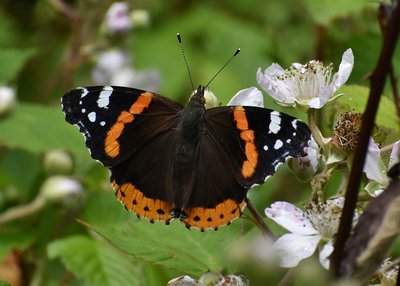
- Red Admiral - Heddon Valley 24.06.2019
An overnight stop not far from Daneway Banks on the way back home gave me the chance to catch up with Large Blue.
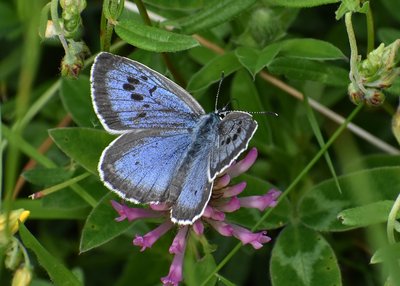
- Large Blue - Daneway Banks 26.06.2019
This was my first visit to Daneway and although I managed to get a few open wing shots in the late afternoon when we arrived, the following day was the hottest one of the year so far and most of the Large Blues soon disappeared into hiding, although I did manage to find three mating pairs during the day. Daneway Banks also produced my first Marbled Whites of the year along with a nice selection of other species.
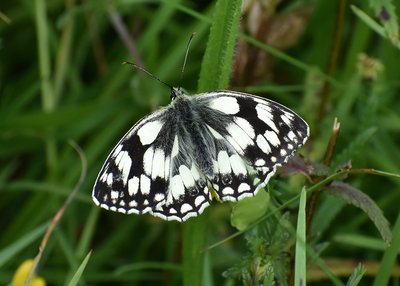
- Marbled White - Daneway Banks 26.06.2019
Back home again and going into early July, Ringlets and Marbled Whites had now appeared locally although neither of these appeared to be quite as numerous as in previous years.
A visit to Oversley Wood near Alcester on July 7th produced quite a few Silver-washed Fritillaries, lots of Ringlets and half a dozen or so Red Admirals. Also my first Small Skippers, Purple Hairstreaks and White Admiral for the year.
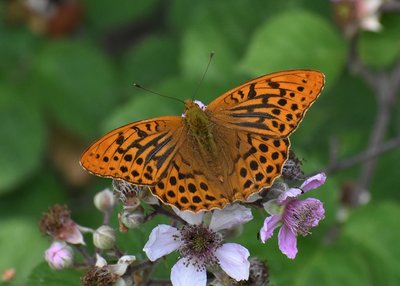
- Silver-washed Fritillary - Oversley Wood 07.07.2019
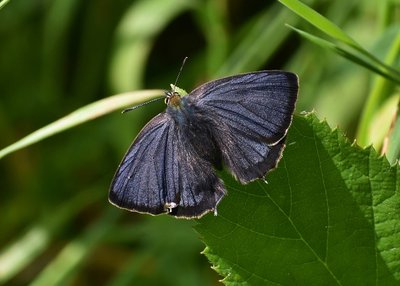
- My first ever open wing male Purple Hairstreak - Oversley Wood 07.07.2019
As July continued the weather threw plenty of cloudy days at us, especially at the weekends. Essex Skippers had now joined the Smalls although I got the impression that neither species had a particularly good year around here although from reports I have seen they did better elsewhere around Warwickshire.
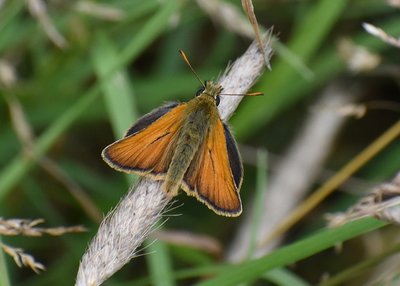
- Small Skipper - Langley Hall 12.07.2019
Gatekeepers were flying by mid July and these definitely had a better year around here this year than in 2018.
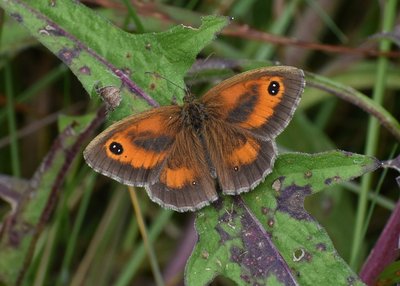
- Gatekeeper - Castle Hills Solihull 21.07.2019
Despite having seen very few whites earlier in the year, the second half of July saw good numbers of Green-veined Whites appear with Large and Small joining them soon after. I suspect that, at least as far as the Small and Large Whites are concerned, the local emergence was boosted by immigrants. I don't believe that Green-veined Whites migrate like the other two species but given that they prefer damper habitats, perhaps the cool and wet weather in late spring and early summer had favoured this species.
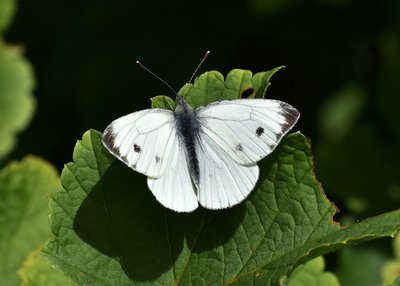
- Green-veined White - Coverdale 21.07.2019
It was also encouraging to see that the good numbers of Small Tortoiseshells seen in the spring had led to reasonable numbers of summer brood. Still not as many as years ago but certainly much better than the last couple of years.
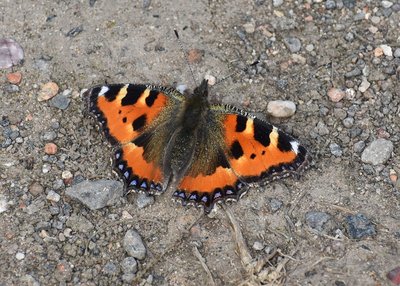
- Small Tortoiseshell - Castle Hills Solihull 21.07.2019
At the end of July, I took a long overdue run down the M40 to Aston Rowant. I had been surprised to see that my last visit there had been in 2014 which meant that it had been five years since I had last seen Silver-spotted Skippers. As mentioned earlier, I reckon that the season was now running a little later than the past couple of years and this was backed up by my visit here with the Silver-spotted Skippers appearing to be at the start of their flight period. I saw approx. 25-30 across the site which was far fewer than I have seen there before at this time of year but I saw reports of many more being seen during the following weeks.
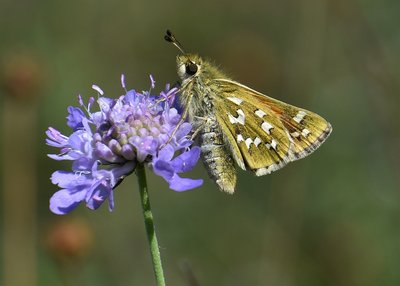
- Silver-spotted Skipper - Aston Rowant 29.07.2019
There were also plenty of Chalk Hill Blues at Aston Rowant plus the usual supporting species, including many Peacocks which seemed to be taking over from the slightly earlier emerging Small Tortoiseshells.
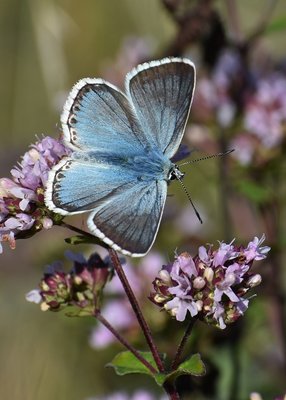
- Chalk Hill Blue - Aston Rowant 29.07.219
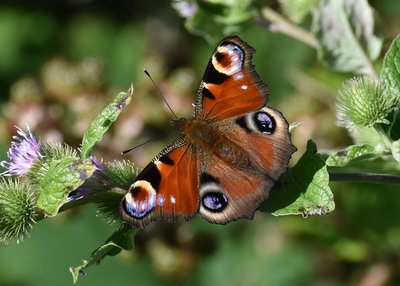
- Peacock - Aston Rowant 29.07.2019
I also saw half a dozen or so Dark Green Fritillaries still flying at Aston Rowant which surprised me a little as these have always been over when I visited there in the past. This also reinforced my thoughts about the season running a little later this year.
Having already mentioned the influx of Painted Ladies , these had been turning up in varying numbers at most places I visited through the summer. At the end of July and into August, I had the first of these in my garden since the invasion of 2009 with two or three on my buddleias on most days, often joined by a Red Admiral or two and the occasional Peacock.
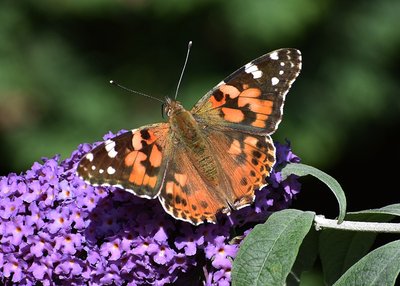
- Painted Lady - Coverdale 02.08.2019
I've waffled on a bit so I will stop there before continuing into late summer in part 3.
To be continued...
Neil.
.
for each and every one
cracking stuff and three gaps from my life list


Fabulous sequence, the pick of which for me is that impressive Large Heath. Never had one pose like that for me!
I'm hoping to go back there next year, apart from any thing else I love going to Latterbarrow.
Goldie
Love the Small Pearls and Walls but the stand out for me is the late, late Marbled White - I keep forgetting to make a trip back to Dorset at that time of year for them

Looking forward to hearing of your plans for next year Neil -if you're down my way give us a shout out
